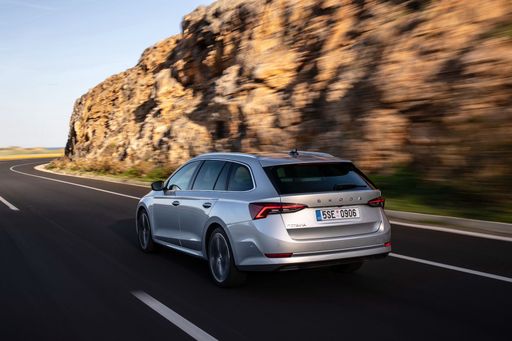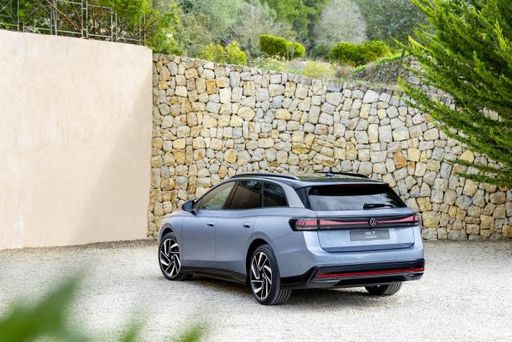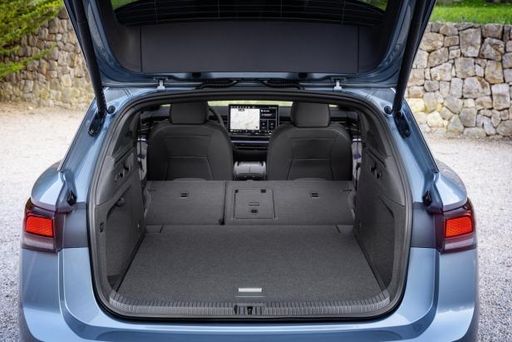In the ever-evolving automotive landscape, the comparison between traditional combustion-engine vehicles and innovative electric models has become increasingly relevant. In this article, we explore the distinct characteristics of the Skoda Octavia Combi and the VW ID.7 Touring, putting them head-to-head in terms of performance, efficiency, and technological advancements.
Skoda Octavia Combi vs VW ID.7 Touring – Which one offers the better deal?
Both models have their strengths – but which one suits you more?
Compare performance, efficiency, price and space directly: Skoda Octavia Combi or VW ID.7 Touring?
Design and Dimensions
Both the Skoda Octavia Combi and the VW ID.7 Touring are designed as wagons, appealing to drivers seeking practicality blended with style. The Octavia measures 4,698 mm in length, making it compact yet spacious, while the ID.7 Touring boasts a larger 4,961 mm length, contributing to enhanced cabin space.
The Octavia's width is 1,829 mm, whereas the ID.7 Touring's 1,862 mm offers a slightly broader stance, further improving comfort for passengers and cargo alike. Height-wise, the ID.7 stands taller at 1,551 mm compared to the Octavia's 1,491 mm, providing a commanding view of the road.
Powertrains and Performance
Under the hood, the Skoda Octavia Combi presents a diverse range of engine options, including petrol, petrol mild-hybrid (MHEV), and diesel variants with power outputs ranging from 116 to 265 HP. The acceleration from 0 to 100 km/h varies accordingly; the most powerful variant achieves this in just 6.5 seconds, highlighting its sporty potential.
On the other hand, the VW ID.7 Touring employs a purely electric powertrain, offering two power options of 286 HP and a robust 340 HP. With torque figures reaching up to 679 Nm, the ID.7 captures the essence of electric driving—offering instantaneous power. It can sprint from 0 to 100 km/h in as little as 5.5 seconds, showcasing electric efficiency at its best.
Fuel Efficiency vs. Range
Fuel consumption for the Skoda Octavia Combi ranges from an impressive 4.4 to 6.9 L/100 km, making it a competitive choice for those inclined to traditional fuel sources. In contrast, the VW ID.7 Touring shines with an electric consumption range of 14 to 16.6 kWh/100 km, depending on the model. Its electric range is remarkable, stretching from 584 km to an impressive 690 km, making it suitable for both city commuting and long-distance travel.
Cargo Capacity and Practicality
Practicality is a critical aspect of any wagon, and both models deliver. The Skoda Octavia Combi offers a trunk capacity of 640 liters, providing ample space for luggage and everyday items. The ID.7 Touring, while slightly exceeding in size, boasts an even larger trunk capacity of 605 liters, making it equally adept at carrying cargo.
Both vehicles come equipped with five seats, ensuring they remain family-friendly, while their payload capacities are also comparable, with the Octavia slightly edging out the ID.7 with figures of up to 534 kg versus the ID.7's maximum of 461 kg.
Innovative Technologies
In terms of technological innovations, both vehicles feature state-of-the-art infotainment and driver-assistance systems. The Skoda Octavia Combi integrates Skoda’s latest multimedia features, equipped with a user-friendly interface that enhances in-car connectivity. Meanwhile, the VW ID.7 Touring offers a cutting-edge digital cockpit and a suite of advanced driver assistance systems, taking safety and convenience to the next level.
Both models are compatible with the latest digital services, but the VW ID.7 leans heavily on its electric-centric technology, providing options for smart charging and connectivity features specifically designed for electric vehicles.
Conclusion: Which is Right for You?
Choosing between the Skoda Octavia Combi and the VW ID.7 Touring ultimately comes down to personal preference and driving needs. The Octavia presents a tried-and-true option for those who prefer traditional engines with a blend of practicality and performance. In contrast, the ID.7 Touring epitomizes the future of mobility with its electric capabilities, offering sustainability without compromising on performance.
Whether you're in the market for a versatile wagon or looking to embrace the electric revolution, both models stand out in their own rights, catering to a diverse array of drivers.
Here’s where it gets real: The technical differences in detail
Costs and Efficiency:
When it comes to price and running costs, the biggest differences usually appear. This is often where you see which car fits your budget better in the long run.
Skoda Octavia Combi has a significantly advantage in terms of price – it starts at 24400 £, while the VW ID.7 Touring costs 47100 £. That’s a price difference of around 22641 £.
Engine and Performance:
Power, torque and acceleration say a lot about how a car feels on the road. This is where you see which model delivers more driving dynamics.
When it comes to engine power, the VW ID.7 Touring has a evident edge – offering 340 HP compared to 265 HP. That’s roughly 75 HP more horsepower.
In acceleration from 0 to 100 km/h, the VW ID.7 Touring is slightly quicker – completing the sprint in 5.50 s, while the Skoda Octavia Combi takes 6.50 s. That’s about 1 s faster.
In terms of top speed, the Skoda Octavia Combi performs evident better – reaching 250 km/h, while the VW ID.7 Touring tops out at 180 km/h. The difference is around 70 km/h.
There’s also a difference in torque: VW ID.7 Touring pulls clearly stronger with 679 Nm compared to 370 Nm. That’s about 309 Nm difference.
Space and Everyday Use:
Beyond pure performance, interior space and usability matter most in daily life. This is where you see which car is more practical and versatile.
Both vehicles offer seating for 5 people.
In curb weight, Skoda Octavia Combi is convincingly lighter – 1366 kg compared to 2191 kg. The difference is around 825 kg.
In terms of boot space, the Skoda Octavia Combi offers minimal more room – 640 L compared to 605 L. That’s a difference of about 35 L.
In maximum load capacity, the VW ID.7 Touring performs minimal better – up to 1714 L, which is about 14 L more than the Skoda Octavia Combi.
When it comes to payload, Skoda Octavia Combi to a small extent takes the win – 534 kg compared to 465 kg. That’s a difference of about 69 kg.
Who comes out on top?
Overall, the Skoda Octavia Combi shows itself to be wins the duel decisively and secures the title of DriveDuel Champion.
It convinces with the more balanced overall package and proves to be the more versatile choice for everyday use.
 @ Škoda Auto a.s. / Škoda Storyboard
@ Škoda Auto a.s. / Škoda Storyboard
Skoda Octavia Combi
Skoda Octavia Combi
The Skoda Octavia Combi is the sensible family wagon that somehow turns grocery runs and long trips into a pleasant, unshowy experience — spacious, practical and built like it prefers reliability over flash. With smart touches, clever storage and a cabin that feels grown-up rather than frugal, it’s an easy recommendation for buyers who want maximum utility without sacrificing comfort or style.
details @ Škoda Auto a.s. / Škoda Storyboard
@ Škoda Auto a.s. / Škoda Storyboard
 @ Škoda Auto a.s. / Škoda Storyboard
@ Škoda Auto a.s. / Škoda Storyboard
 @ Škoda Auto a.s. / Škoda Storyboard
@ Škoda Auto a.s. / Škoda Storyboard
 @ Škoda Auto a.s. / Škoda Storyboard
@ Škoda Auto a.s. / Škoda Storyboard
VW ID.7 Touring
The VW ID.7 Touring blends sleek, aerodynamic fastback looks with estate practicality, delivering an electric family car that looks grown-up and feels refined. Inside it's calm and spacious with clever storage and modern tech, swallowing suitcases and weekend plans with ease — a sensible, slightly flashy choice for buyers who want electric comfort without giving up practicality.
details @ Volkswagen
@ Volkswagen
 @ Volkswagen
@ Volkswagen
 @ Volkswagen
@ Volkswagen
 @ Škoda Auto a.s. / Škoda Storyboard
@ Škoda Auto a.s. / Škoda Storyboard
|
 @ Volkswagen
@ Volkswagen
|
|
|
|
Costs and Consumption |
|
|---|---|
|
Price
24400 - 42300 £
|
Price
47100 - 54900 £
|
|
Consumption L/100km
4.4 - 6.9 L
|
Consumption L/100km
-
|
|
Consumption kWh/100km
-
|
Consumption kWh/100km
14 - 16.6 kWh
|
|
Electric Range
-
|
Electric Range
584 - 689 km
|
|
Battery Capacity
-
|
Battery Capacity
77 - 86 kWh
|
|
co2
113 - 157 g/km
|
co2
0 g/km
|
|
Fuel tank capacity
45 - 55 L
|
Fuel tank capacity
-
|
Dimensions and Body |
|
|---|---|
|
Body Type
Estate
|
Body Type
Estate
|
|
Seats
5
|
Seats
5
|
|
Doors
5
|
Doors
5
|
|
Curb weight
1366 - 1553 kg
|
Curb weight
2191 - 2336 kg
|
|
Trunk capacity
640 L
|
Trunk capacity
605 L
|
|
Length
4698 - 4709 mm
|
Length
4961 mm
|
|
Width
1829 mm
|
Width
1862 mm
|
|
Height
1455 - 1468 mm
|
Height
1549 - 1551 mm
|
|
Max trunk capacity
1700 L
|
Max trunk capacity
1714 L
|
|
Payload
471 - 534 kg
|
Payload
459 - 465 kg
|
Engine and Performance |
|
|---|---|
|
Engine Type
Petrol, Petrol MHEV, Diesel
|
Engine Type
Electric
|
|
Transmission
Automatic, Manuel
|
Transmission
Automatic
|
|
Transmission Detail
Dual-Clutch Automatic, Manual Gearbox
|
Transmission Detail
Reduction Gearbox
|
|
Drive Type
Front-Wheel Drive, All-Wheel Drive
|
Drive Type
Rear-Wheel Drive, All-Wheel Drive
|
|
Power HP
116 - 265 HP
|
Power HP
286 - 340 HP
|
|
Acceleration 0-100km/h
6.5 - 10.7 s
|
Acceleration 0-100km/h
5.5 - 6.7 s
|
|
Max Speed
203 - 250 km/h
|
Max Speed
180 km/h
|
|
Torque
220 - 370 Nm
|
Torque
545 - 679 Nm
|
|
Number of Cylinders
4
|
Number of Cylinders
-
|
|
Power kW
85 - 195 kW
|
Power kW
210 - 250 kW
|
|
Engine capacity
1498 - 1984 cm3
|
Engine capacity
-
|
General |
|
|---|---|
|
Model Year
2024 - 2025
|
Model Year
2024
|
|
CO2 Efficiency Class
E, F, D, C
|
CO2 Efficiency Class
A
|
|
Brand
Skoda
|
Brand
VW
|
Is the Skoda Octavia Combi offered with different drivetrains?
The Skoda Octavia Combi is available as Front-Wheel Drive or All-Wheel Drive.
The prices and data displayed are estimates based on German list prices and may vary by country. This information is not legally binding.
